
Last Saturday I took to the hills above Ardgartan to climb The Brack and Cnoc Coinnich, both of which are classed as Corbetts. I had not planned to be on the hills at all that day, but the sight of bright blue sky above early morning mists in the Blane Valley proved irresistible. Armed with an old OS map and a hastily printed route description from the Walkhighlands website – with so much commercial forestry in the area I reckoned extra help in finding a way on to the hills and off at the end of the day would be needed – I set off from Ardgartan visitor centre along a section of forest track forming part of the Cat Craig loop, presumably a cycle route.
The footpath for The Brack is clearly signed where it leaves the forest track and lifted me quickly above the dismal forestry. Like most of the hills around Arrochar, The Brack and Cnoc Coinnich present characterful upper slopes rich in interesting detail while the lower and mid slopes have been stifled under a blanket of dull green conifers. It was an exhiliarating day, the fascinating skylines of gnarly summits in all directions marred only by the tide of commercial forestry lapping at their flanks.
(Below) Looking East from Cnoc Coinnich (Glen Douglas far left)
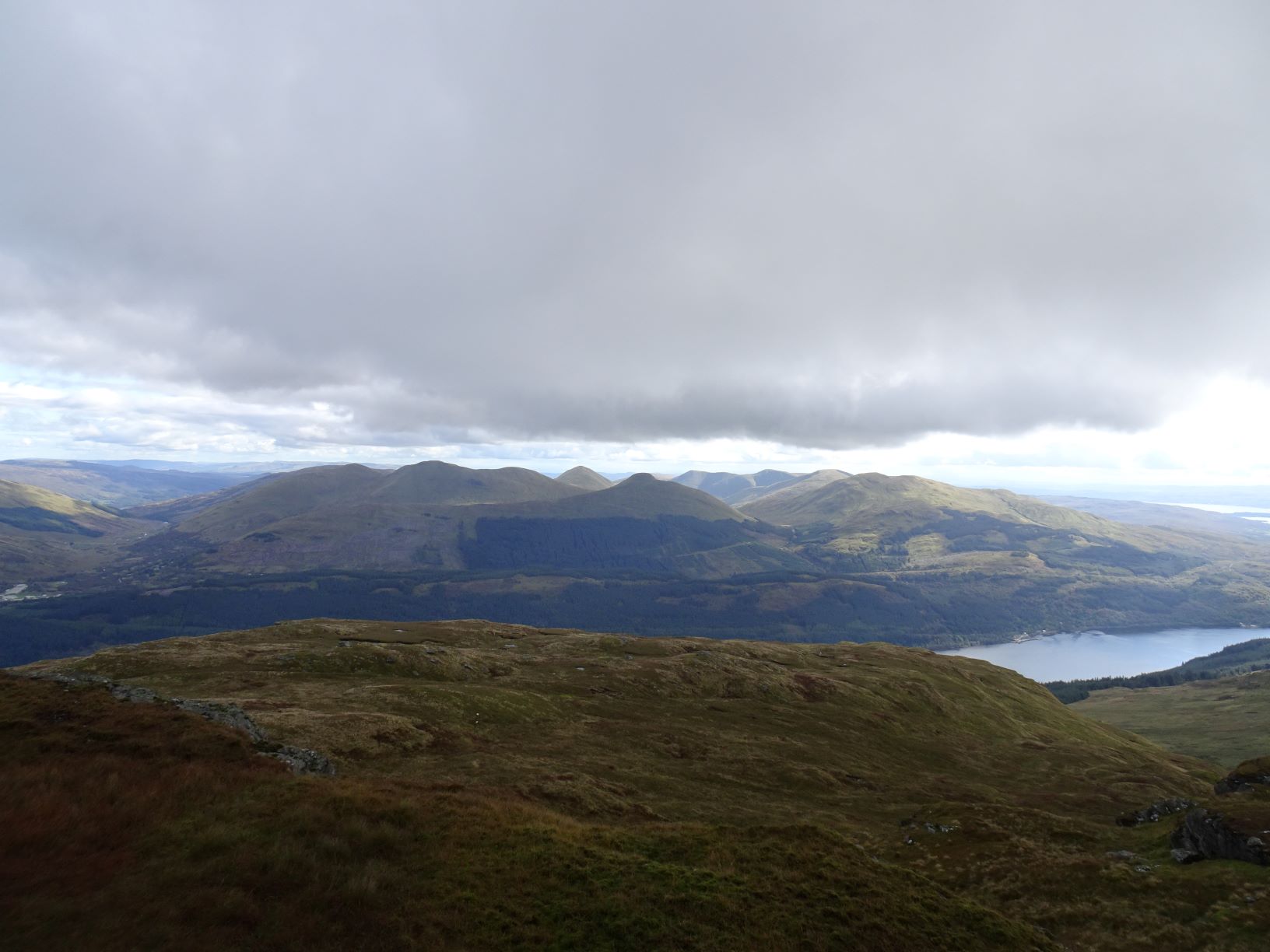
I had initially considered retracing my steps over The Brack from Coinnich to descend by my route of ascent, but opted in the end to walk out by Coilessan Glen and the Cowal Way, largely out of curiosity to see what had happened to the forestry track “upgrades” condemned by Nick Kempe in his blog of November 2017 (see here).
I had cause to regret my decision more than once on what must be one of the most dismal walk outs from any hill. It’s nobody’s fault that the Cowal Way, as it cuts across the col between The Brack and Cnoc Coinnich, is a swamp concealed by shaggy long grass. The mess lower down, however, is purely human in origin and shows the ex-Forestry Commission in a very poor light indeed. What must walkers along the Cowal Way think when, having escaped the bog and descended the steep section of waymarked path alongside the trees, they meet the scenes shown in the photographs which follow?
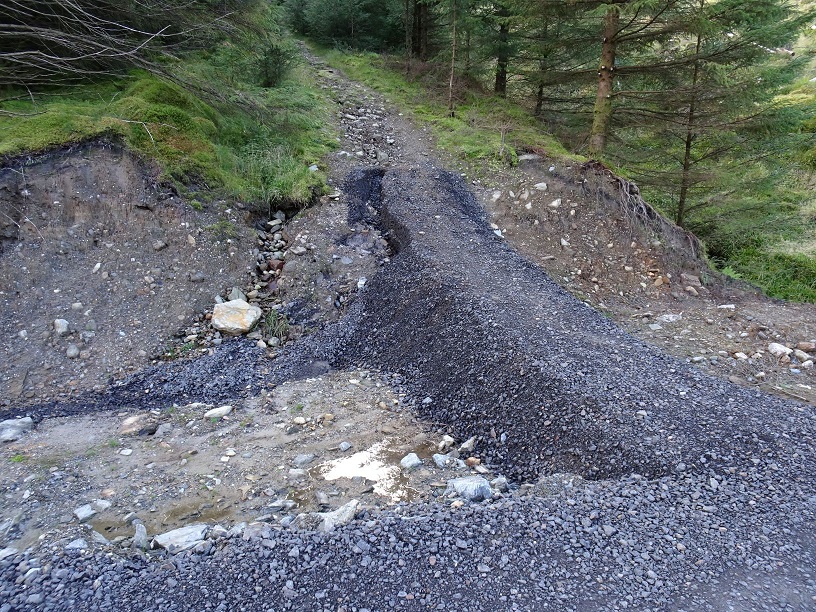
Immediately to the left (looking down), a massive culvert indicates the volume of water expected to course down these ravaged slopes in periods of high rainfall or snow melt. There are signs that the boulders screening the pipe won’t be in place for too long.
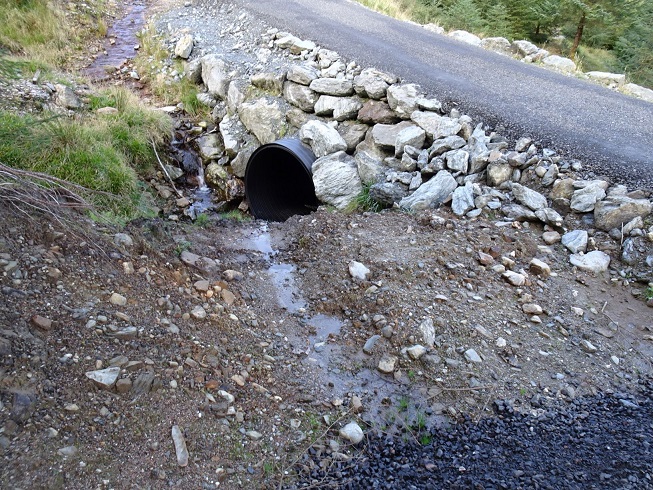
To the right, a bleak view of an industrial highway that seems unlikely to resist erosion in the medium to long term. How do those trees stay in place?
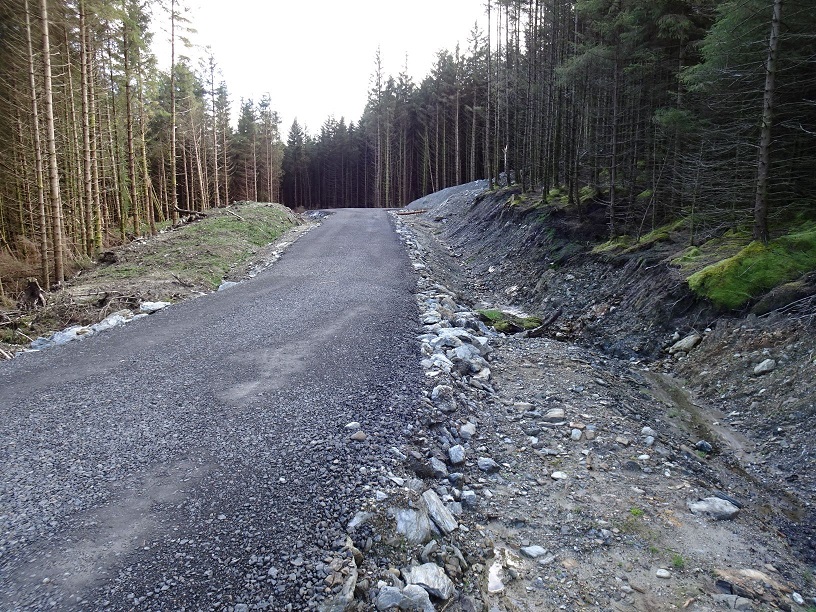
The old Cowal Way path resumes on the far side of the forestry track, but only for a short distance. I noted that, in at least one place, young conifers were growing together across the path and will eventually block the way. This may indicate that most walkers simply take to the forest track at the junction above and few now bother with the original path. This is easy to understand: after a short distance the path rejoins the same track again (see photograph below) and from here on the walker has no option but to keep to the track/motorway.
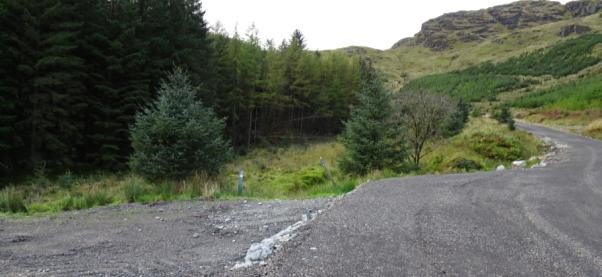
Admittedly the upgraded track surface is less hard on the joints than tarmac, but the experience is dismal as you head downhill towards Loch Long. Views are almost non-existent, the track verges are shoddy and the track surface itself appears to be breaking up already
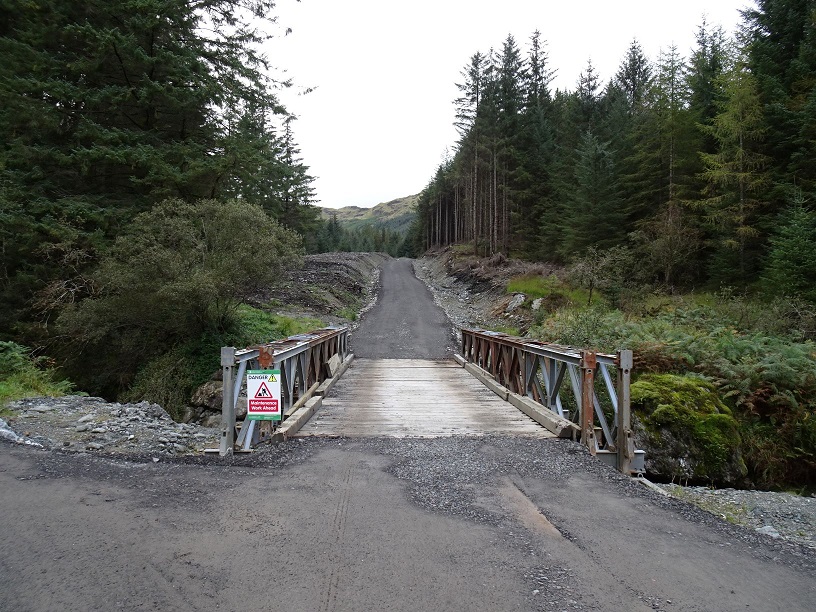
The Walkhighlands route description is clearly somewhat out of date but was invaluable at junctions such as the one shown above.
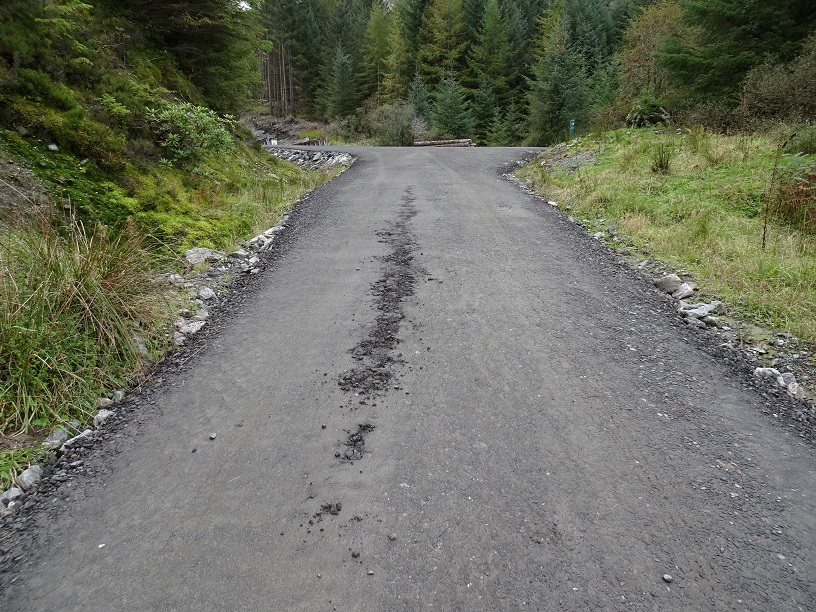
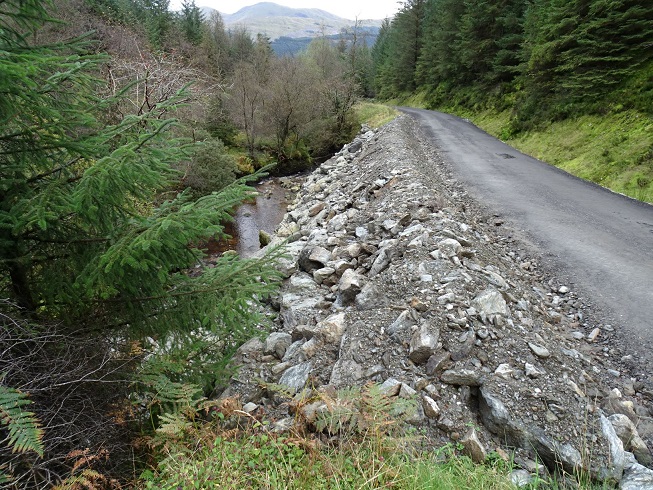
Eventually I escaped on to another track and from there across a bridge that seemed to be under renovation, eventually reaching a single track road. Two LLTNPA signs informed me that I was in a camping management zone and would need a permit to camp on the shores of the loch on … what kind of pitch exactly? Peering through the beautiful beech woodland I spied a possible pitch for a small tent (on the right in the picture below) but the rest of the area did not look campable. There may well be suitable ground closer to the Coilessan houses – one of the signs indicated as much but I did not have time to go down to the shore to check – but for the walker coming from Ardgartan this area of woodland is presented as campable. Other than the small green area glimpsed through the trees, your choices are somewhat limited …
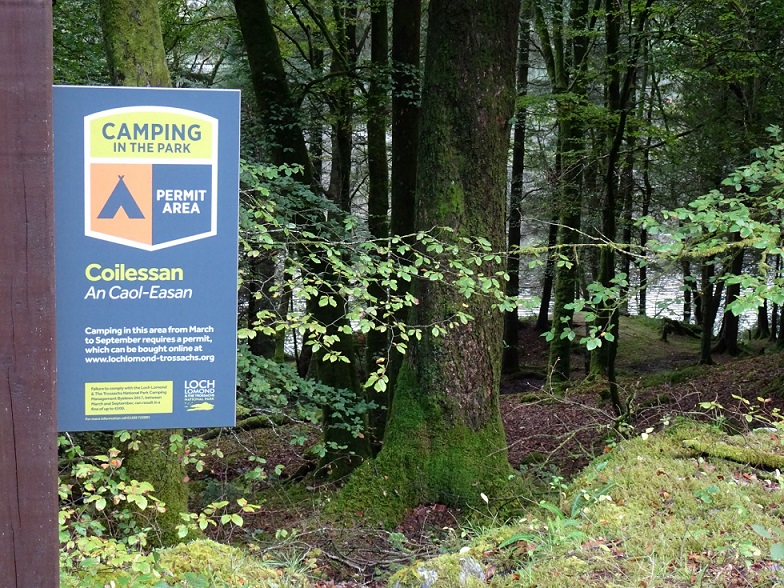
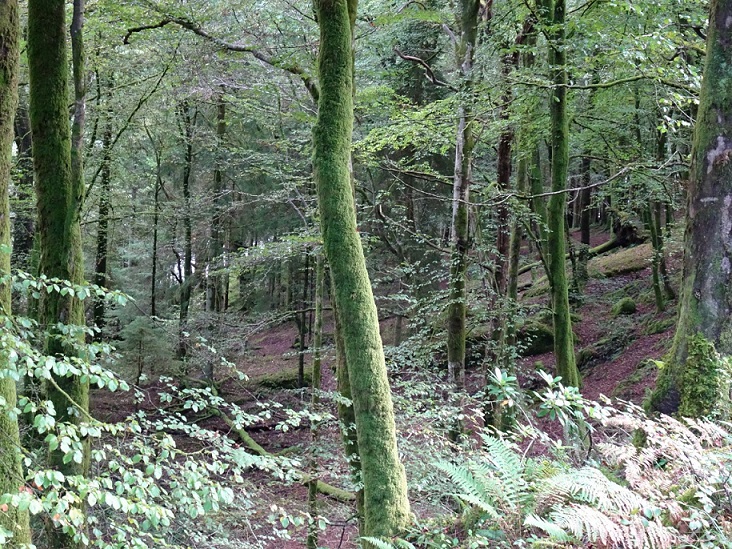
I left the single track road eventually to follow the Ardgartan shore walk, which is also part of the Cowal Way. I could not help thinking that anyone walking this route from the Ardgartan side would think they had struck lucky as they followed the narrow footpath through mature broadleaf woodland by a rushing burn, along the peaceful shores of Loch Long and up on to the pleasantly wooded single track road.
What a shock, then, to cross the bridge at the end of the tarmac road and meet the black highway from hell. At least I was lucky to be walking away from the hills after a great day out. Had I been a long-distance walker committed to the Cowal Way it would have been a very different story.
The Forestry and Land Sccotland website promotes a fairytale in which the visitor is promised “endless trails through an area of vast natural beauty”. “The trails offer great views”, it trumpets, with the forest of Sitka and Norway spruce described as providing “ideal habitat for red squirrel, roe deer, buzzards, owls”. The truth is that any views have long since been swallowed up by conifers. As for wildlife, in all the time I spent tramping the forest tracks I saw and heard one robin.
That this corner of the National Park should have been abandoned to commercial forestry interests is not only sad, it is shameful.
I will not be back.
I couldn’t agree more Jane. A complete mess, as is much of ‘Argyll’s Bowling Green’. Utterly destroyed by the Forestry Commission. Loch Lomond & Trossachs National Park is nothing more than an ill designed obelisk on the road north. Their political masters have rendered them helpless against the industrial demands of landowners. Glen Falloch hydro, Cononish gold mine, the list goes on. I always have a laugh when get off the plane at Glasgow Airport and you hear the birdsong and see all those huge pictures of the best bits. Please keep up the good work Parkswatch.
RW
Thank you, Robert, I’m always amazed at how few people seem to object to the vast sea of conifers blanketing the hillsides. Is it because most of them know no different, don’t know what these places used to be like? Traditional forest tracks were not pretty, but the Coilessan variety is unlike anything I’ve ever seen. It’s like a preparation for Armageddon.
Always find it ironic when someone comments about environmental degradation after getting off a plane…..
Or lives in an urban setting, having driven to and forth for their work, and leisure commenting on environmental damage committed by others.
Least it wasn’t wasted as paper.
Aye, because unless an individual leads a perfect life in a totally exemplary manner at all times, they’re not allowed to express an opinion or campaign for any change or improvement whatsoever, obviously…
It can be quite problematic to live such a perfect life as an individual, locked within and functioning as part of a system, when so many of the problems, and solutions, are systemic.
Thanks for your comment. There is certainly ongoing debate among outdoor organisations and individuals about the ways in which people access the hills, rivers etc., including means of transport to and from. My post, however, was concerned with a rather different issue (though I agree that everything connects with everything else on some level). If you haven’t already seen it, take a look at Nick’s recent post about using public transport to access the Glen Falloch hills. We’re still well short of a public transport system that offers a convenient, climate-friendly alternative to the car.
Yes a different issue I am fully aware of that.
Perhaps we should remember that it is a working environment and not a wrapped in aspic.
What is primary produce in this instance wood, moves on to be utilised in other parts of the economy both local and national and to deny those that own and manage these assets a reasonable right to utilise them is not on. All you do is move the source of that consumed primary product elsewhere
I had not meant to write initially, let it be as it were, but the the comment about getting off at the airport just smacked of little thought as to what was before,(and is now in comparison to a woodland) ie alder birch woodland centuries back, then grassland, then an airport most certainly devoid of birdsong etc on its mere 2600* 40m concrete pad and ancillary hardstanding.
I see a problem of proportion, or rather, of disproportion. Humans have evolved to do everything on an industrial scale in a way that nature would never have chosen. There is no balance. People make money and enjoy their rights while nature is bankrupted and deprived of rights. I spend a lot of time in the uplands and am saddened by the utter dearth of wildlife and the dominance of monoculture, conifers to the fore. Biodiversity collapse is staring us in the face and the people with the power to do something about it on a large scale look away. But that’s the way it’s always been, which is why we are where we are and why little, if anything, is going to change.
At one level Scotland’s inner city youth still claim that they are bored, and have little to do. At the other level we see “party goers” of working age attending festivals and concerts, then leaving camping equipment and general mess behind them, because it is so cheap – modern lightweight tents so complicated to pack away. The same littering mentality and lack of social conscience in public places has led to a backlash from authority and from land owners who place ever greater restrictions undermining “open access” to restrict to narrow corridors where recreation may take place.
There is a clear cause and effect here. Treat people well , and they will take care to respect the places they visit: treat them like “cattle” to be “administered”, penned in , kept “controlled” and one consequence ( as with any weak fence around cattle!) is perfectly predictable. The debate over the need for open access for the leisure industry to enjoy Scotland’s open space heritage , and for schools and colleges to offer training for all in social responsibility has a long way to run. The sad lack of leisure sailors on Loch Lomond today, the restrictions on casual overnight stays, the lack of litter bins or safe pathways beside the A82 for cyclists and walkers, all this serves as a ‘barometer’ of current attitudes in the Park “Control” centre. (Gang warfare taking place not 30 miles away is another)
Rhetorical question – Is it cheaper for ‘society’ to Police social unrest, than to provide a well funded professional ranger team, servicing facilities and educating the public, across a well run national park?